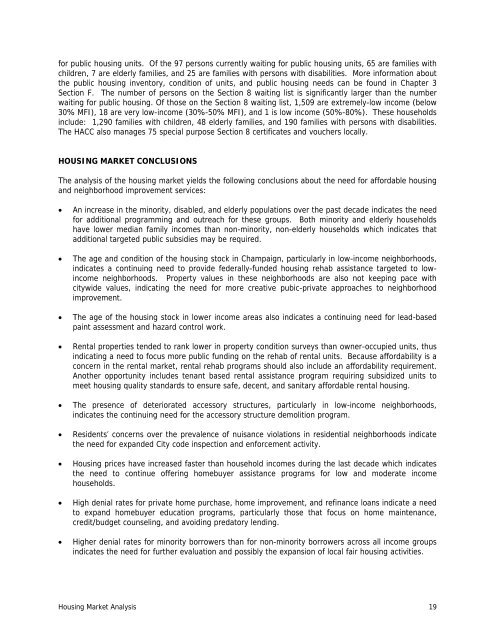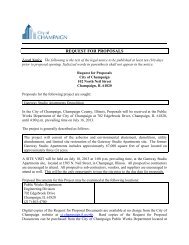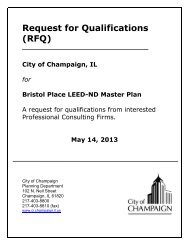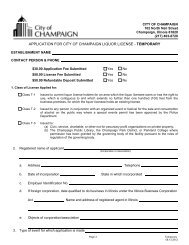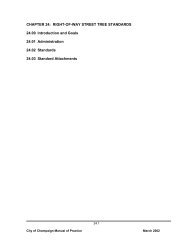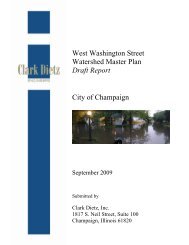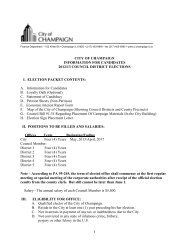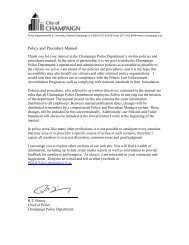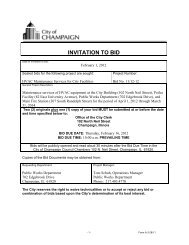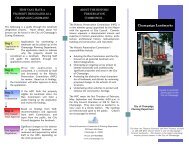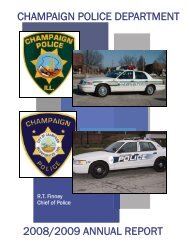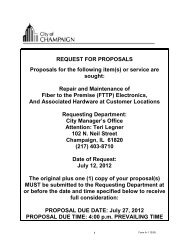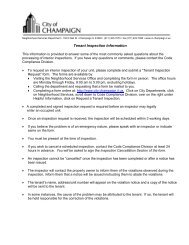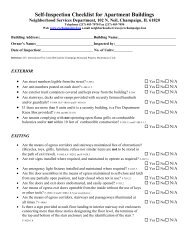2010-2014 Consolidated Plan - City of Champaign
2010-2014 Consolidated Plan - City of Champaign
2010-2014 Consolidated Plan - City of Champaign
Create successful ePaper yourself
Turn your PDF publications into a flip-book with our unique Google optimized e-Paper software.
for public housing units. Of the 97 persons currently waiting for public housing units, 65 are families withchildren, 7 are elderly families, and 25 are families with persons with disabilities. More information aboutthe public housing inventory, condition <strong>of</strong> units, and public housing needs can be found in Chapter 3Section F. The number <strong>of</strong> persons on the Section 8 waiting list is significantly larger than the numberwaiting for public housing. Of those on the Section 8 waiting list, 1,509 are extremely-low income (below30% MFI), 18 are very low-income (30%-50% MFI), and 1 is low income (50%-80%). These householdsinclude: 1,290 families with children, 48 elderly families, and 190 families with persons with disabilities.The HACC also manages 75 special purpose Section 8 certificates and vouchers locally.HOUSING MARKET CONCLUSIONSThe analysis <strong>of</strong> the housing market yields the following conclusions about the need for affordable housingand neighborhood improvement services:• An increase in the minority, disabled, and elderly populations over the past decade indicates the needfor additional programming and outreach for these groups. Both minority and elderly householdshave lower median family incomes than non-minority, non-elderly households which indicates thatadditional targeted public subsidies may be required.• The age and condition <strong>of</strong> the housing stock in <strong>Champaign</strong>, particularly in low-income neighborhoods,indicates a continuing need to provide federally-funded housing rehab assistance targeted to lowincomeneighborhoods. Property values in these neighborhoods are also not keeping pace withcitywide values, indicating the need for more creative pubic-private approaches to neighborhoodimprovement.• The age <strong>of</strong> the housing stock in lower income areas also indicates a continuing need for lead-basedpaint assessment and hazard control work.• Rental properties tended to rank lower in property condition surveys than owner-occupied units, thusindicating a need to focus more public funding on the rehab <strong>of</strong> rental units. Because affordability is aconcern in the rental market, rental rehab programs should also include an affordability requirement.Another opportunity includes tenant based rental assistance program requiring subsidized units tomeet housing quality standards to ensure safe, decent, and sanitary affordable rental housing.• The presence <strong>of</strong> deteriorated accessory structures, particularly in low-income neighborhoods,indicates the continuing need for the accessory structure demolition program.• Residents’ concerns over the prevalence <strong>of</strong> nuisance violations in residential neighborhoods indicatethe need for expanded <strong>City</strong> code inspection and enforcement activity.• Housing prices have increased faster than household incomes during the last decade which indicatesthe need to continue <strong>of</strong>fering homebuyer assistance programs for low and moderate incomehouseholds.• High denial rates for private home purchase, home improvement, and refinance loans indicate a needto expand homebuyer education programs, particularly those that focus on home maintenance,credit/budget counseling, and avoiding predatory lending.• Higher denial rates for minority borrowers than for non-minority borrowers across all income groupsindicates the need for further evaluation and possibly the expansion <strong>of</strong> local fair housing activities.Housing Market Analysis 19


